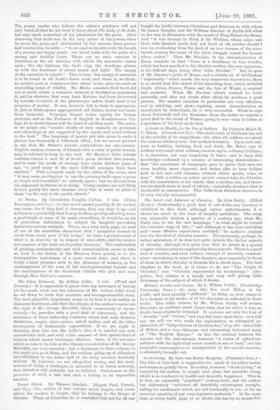Travel Sketch. By Thomas Sinclair. (Kegan Paul, Trench, and Co.)—The
author of this volume never forgets, and never allows his readers to forget, that he belongs to the House of Sinclair. When at Gibraltar, he is reminded that not far off was
fought the battle between Christians and Saracens in 1830, where Sir James Douglas and Sir William Sinclair of Roslin fell when
on the way to Jerusalem with the heart of King Robert the Bruce.
And "it was strange to think if Sir William, whose ashes mix there with Spanish earth, had not lived at all, neither should I
now be overlooking from the deck of an iron steamer of the nine- teenth century the scene of the fatal struggle round the famous silver casket." Then Mr. Sinclair, in his characterisation of Knox, reminds us that "there is a steadiness in him besides, which has been ascribed to his Sinclair mother, his own signature, in his difficult days, being often 'John . Sinclair.' " Yet, in spite of Mr. Sinclair's pride of House, and a certain air of intellectual " superiority " which marks his very numerous digressions, there is no doubt that this sketch of his travelling tour, which included North Africa, France, Wales, and the Isle of Wight, is original and readable. When Mr. Sinclair allows himself to write naturally, and does not strain after effect, he produces a good picture. His smaller sketches in particular are very effective, and in catching, and photpgraphing, racial characteristics as manifested by individuals, he is very successful. What he says about Normandy and the Normans—from the latter he expects a. great deal in the event of France going to war—may be taken as a specimen of his book at its best.


































 Previous page
Previous page